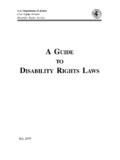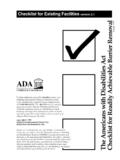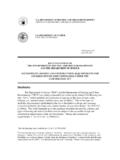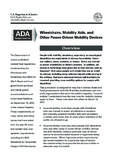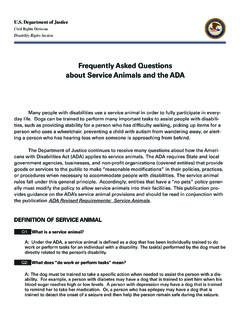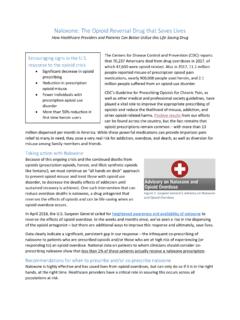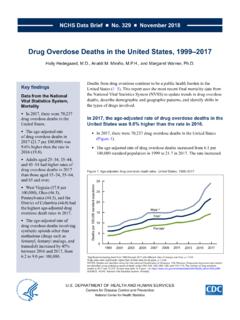Transcription of The Americans with Disabilities Act and the Opioid Crisis ...
1 The Americans with Disabilities Act and the Opioid Crisis : Combating Discrimination Against People in Treatment or Recovery The Opioid Crisis poses an extraordinary challenge to communities throughout our country. The Department of Justice (the Department) has responded with a comprehensive approach prioritizing prevention, enforcement, and treatment. This includes enforcing the Americans with Disabilities Act (ADA), which prohibits discrimination against people in recovery from Opioid use disorder (OUD) who are not engaging in illegal drug use, including those who are taking legally-prescribed medication to treat their OUD. This guidance document provides information about how the ADA can protect individuals with OUD from discrimination an important part of combating the Opioid epidemic across American communities.
2 While this document focuses on individuals with OUD, the legal principles discussed also apply to individuals with other types of substance use disorders. 1) What is the ADA? The ADA is a federal law that gives civil rights protections to individuals with Disabilities in many areas of life. The ADA guarantees that people with Disabilities have the same opportunities as everyone else to enjoy employment opportunities, 1 participate in state and local government programs,2 and purchase goods and services. 3 For example, the ADA protects people with Disabilities from discrimination by social services agencies; child welfare agencies; courts;. prisons and jails; medical facilities, including hospitals, doctors' offices, and skilled nursing facilities; homeless shelters; and schools, colleges, and universities.
3 2) Does an individual in treatment or recovery from Opioid use disorder have a disability under the ADA? Typically, yes, unless the individual is currently engaged in illegal drug use. See Question 5. The ADA prohibits discrimination on the basis of disability. 4 The ADA defines disability as (1) a physical or mental impairment that substantially limits one or more major life activities, including major bodily functions; (2) a record of such an impairment; or (3) being regarded as having such an impairment. 5. People with OUD typically have a disability because they have a drug addiction that substantially limits one or more of their major life activities. Drug addiction is considered a physical or mental impairment under the Drug addiction occurs when the repeated use of drugs causes clinically significant impairment, such as health problems and or an inability to meet major responsibilities at work, school, or home.
4 7 People with OUD may therefore experience a substantial limitation of one or more major life activities, such as caring for oneself, learning, concentrating, thinking, communicating, working, or the operation of major bodily functions, including neurological and brain The ADA also protects individuals who are in recovery, but who would be limited in a major life activity in the absence of treatment and/or services to support recovery. 9. 3) Does the ADA protect individuals who are taking legally prescribed medication to treat their Opioid use disorder? Yes, if the individual is not engaged in the illegal use of drugs. Under the ADA, an individual's use of prescribed medication, such as that used to treat OUD, is not an illegal use of drugs if the individual uses the medication under the supervision of a licensed health care professional, including primary care or other non-specialty providers.
5 10 This includes medications for Opioid use disorder (MOUD) or medication assisted treatment (MAT). MOUD is the use of one of three medications (methadone, buprenorphine, or naltrexone) approved by the Food and Drug Administration (FDA) for treatment of OUD; 11 MAT refers to treatment of OUD and certain other substance use disorders by combining counseling and behavioral therapies with the use of FDA-approved Example A. A skilled nursing facility refuses to admit a patient with OUD because the patient takes doctor-prescribed MOUD, and the facility prohibits any of its patients from taking MOUD. The facility's exclusion of patients based on their OUD would violate the ADA. Example B. A jail does not allow incoming inmates to continue taking MOUD prescribed before their detention.
6 The jail's blanket policy prohibiting the use of MOUD would violate the ADA. 2. 4) Does the ADA protect individuals with Opioid use disorder who currently participate in a drug treatment program? Yes. Individuals whose OUD is a disability and who are participating in a supervised rehabilitation or drug treatment program are protected by the ADA if they are not currently engaging in the illegal use of drugs. 13 See explanation in Question 5. It is illegal to discriminate against these individuals based on their treatment for OUD. Example C. A doctor's office has a blanket policy of denying care to patients receiving treatment for OUD. The office would violate the ADA if it excludes individuals based on their OUD. Example D. A town refuses to allow a treatment center for people with OUD to open after residents complained that they did not want those kind of people in their area.
7 The town may violate the ADA if its refusal is because of the residents' hostility towards people with OUD. 5) Does the ADA protect individuals who are currently illegally using opioids? Generally, no. With limited exceptions, the ADA does not protect individuals engaged in the current illegal use of drugs if an entity takes action against them because of that illegal drug use. 14 Current illegal use of drugs means illegal use of drugs that occurred recently enough to justify a reasonable belief that a person's drug use is current or that continuing use is a real and ongoing Illegal use, however, does not include taking a medication, including an Opioid or medication used to treat OUD, under the supervision of a licensed health care Example E.
8 A mentoring program requires its volunteers to provide test results showing that they do not engage in the illegal use of drugs. The program dismisses a volunteer who tests positive for opioids for which the volunteer does not have a valid prescription. This does not violate the ADA because the dismissal was based on current illegal drug use. 3. In addition, an individual cannot be denied health services, or services provided in connection with drug rehabilitation, on the basis of that individual's current illegal use of drugs, if the individual is otherwise entitled to such services. 17 But a drug rehabilitation or treatment program may deny participation to individuals who engage in illegal use of drugs while they are in the program.
9 18. Example F. A hospital emergency room routinely turns away people experiencing drug overdoses, but admits all other patients who are experiencing emergency health issues. The hospital would be in violation of the ADA for denying health services to those individuals because of their current illegal drug use, since those individuals would otherwise be entitled to emergency services. Example G. A drug rehabilitation program asks a participant to leave because that participant routinely breaks a rule prohibiting the use of illegal drugs while in the program. This is not discrimination under the ADA because the program can require participants to abstain from illegal drugs while in the program. 6) Does the ADA protect individuals with a history of past Opioid use disorder, who no longer illegally use drugs?
10 Yes. The ADA protects individuals with a record of disability. As explained above in Question 2, OUD typically qualifies as a disability. Therefore, individuals with a record of having OUD. usually will be protected under the Individuals would fall into this category if they have a history of, or have been misclassified as having, OUD. 20. Example H. A city terminates an employee based on his disclosure that he completed treatment for a previous addiction to prescription opioids. The city may be in violation of the ADA for discriminating against the employee based on his record of OUD. 4. 7) Does the ADA provide any legal protections for individuals who are regarded as having an Opioid use disorder, whether or not they actually have an Opioid use disorder?
